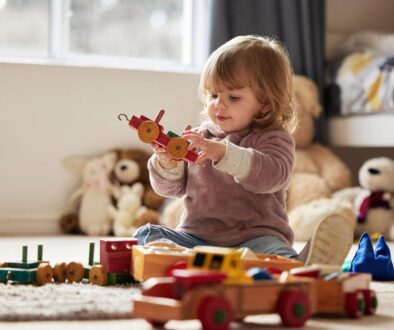Choosing Age-Appropriate Toys for Toddlers

The holidays are here and choosing toys for toddlers seems like it should be easy, but shopping for the perfect gift can often leave you feeling overwhelmed. With the endless array of options, how do you choose which toys are right for your child? How can you tell which are high quality and which will last? Which will engage your child’s interest for more than a few days or weeks? Below are some ideas for choosing toys that will grow with your child, challenge them, and nurture their overall development (cognitive, physical, language and social-emotional skills).
- Choose toys that are “open-ended.” Toddlers love to take apart, put back together, pull out, put in, add on, and build up. Examples: Blocks, interlocking blocks, nesting blocks or cups, and toys for sand and water play.
- Look for toys that will grow with your child. We all know too well the experience of buying a toy that our child plays with for two days and never plays with again. Choose toys that can be played with in a variety of ways. Examples: Plastic toy animals and action figures, toddler-friendly dollhouses, trains, and dump trucks (and other vehicles), stuffed animals and dolls.
- Select toys that encourage exploration and problem-solving. Toys that give kids a chance to figure things out on their own, or with a little help – will build their logical thinking skills and help them become persistent problem-solvers. Examples: Puzzles, shape-sorters, blocks, nesting blocks or cups, art materials like clay, paint, crayons, or playdough.
- Look for toys that spark your child’s imagination. Look for toys that your child can use as he develops and acts out stories. Pretend play builds language and literacy skills, problem-solving skills, and the ability to sequence. Examples: Dress-up clothing, blocks, toy food and plastic plates, action figures, stuffed animals and dolls, trains and trucks, toddler-friendly dollhouses, toy tools.
- “Getting ready to read” toys. Books, magnetic alphabet letters, and art supplies like markers, crayons, and fingerpaints help your child develop early writing and reading skills.
Remember, there is no specific toy necessary for your child to reach their next developmental milestone. There isn’t an app or device that will teach your child to read. While it’s easy to fall for the creative marketing, you are your child’s first and best teacher.
*Toy safety considerations per the AAP: Government regulations, improved safety standards for the manufacture and use of toys, and product testing have made most toys safe when used appropriately for the recommended ages and stages of development. However, unsafe toys can still be found.
In determining toy safety, the features of the toy should be considered as well as how the toy might be used or abused, and the amount of supervision or help needed for safe play. Avoid toys with button batteries or high-powered magnets.
- SaferProducts.gov allows anyone to report toy safety concerns.
- Recalls.gov provides information about toy safety recalls.





